When you imagine a nurse, chances are the picture in your mind includes crisp scrubs and a pair of sturdy, dependable shoes. But here’s the real question: what shoes do nurses wear today? The answer has changed a lot over the years.
Decades ago, nurses were almost always seen in classic white shoes—a symbol of professionalism and tradition. Fast forward to today, and the options look very different. From athletic-inspired sneakers to slip-resistant clogs designed for busy hospital floors, nurse footwear has evolved to meet the demands of modern healthcare.
In this guide, we’ll take a closer look at:
- The most common types of shoes nurses wear in hospitals.
- Why closed-toe shoes are essential for safety in healthcare.
- A quick look at the history of nurse footwear and how it’s changed over time.
- How shoe preferences differ across departments and specialties.
Whether you’re a nursing student buying your first pair or a seasoned nurse looking for a better fit, this guide will help you understand exactly what footwear keeps healthcare moving—one step at a time.
What Shoes Nurses Wear? A Complete Explanation
Nurses wear different types of shoes based on the place and situation demand. Let’s take a deeper look into the types of shoes nurses wear and the reasons they wear them:
Types of Shoes Nurses Wear in Hospitals
Every nurse has their own personal preference when it comes to footwear, but certain categories of shoes dominate hospital hallways. The choice often depends on department demands, foot health, and comfort during long shifts. Here are the most common types of shoes nurses wear in hospitals:
1. Sneakers (Athletic Shoes)
Sneakers have become one of the top choices among nurses, and there are many reasons why they are in search of the perfect nursing sneakers. Let’s take a look at them:
- They provide excellent cushioning and arch support, making them ideal for 10–12 hour shifts spent standing and walking.
- Popular brands like Nike, Skechers, Adidas, Hoka, and Asics are widely seen on hospital floors because they blend comfort with style.
- Athletic shoes are especially favored in fast-paced environments such as the ER and ICU, where nurses need mobility and agility.
2. Clogs
Clogs remain a nursing classic, with brands like Dansko, Alegria, and Crocs trusted by healthcare professionals worldwide.
- They offer strong arch support and help reduce fatigue during long hours.
- Their easy-to-clean surfaces make them a practical choice when dealing with spills or messy situations.
- Most models are slip-resistant and highly durable, making them perfect for surgical units and operating rooms where safety is critical. And maybe that’s why nurses wear clogs, for it’s crazy comfort and support during long hours.
3. Slip-On Work Shoes
For nurses who value convenience, slip-ons are a great option.
- They maintain a professional appearance while being quick to put on and take off.
- Many slip-on models feature water-resistant uppers and non-slip soles, providing both protection and stability.
- These shoes are popular among nurses who move between different departments or need footwear that keeps up with hectic shift changes.
4. Specialized Orthopedic or Supportive Shoes
Not every nurse’s feet are the same, and for those dealing with chronic issues, specialized shoes are a lifesaver.
- These shoes are designed for conditions like flat feet, plantar fasciitis, or chronic back pain.
- They focus on medical-grade support, shock absorption, and posture correction, helping nurses prevent long-term injuries.
- While they may not always be the most stylish option, they prioritize health and comfort—something every nurse appreciates after a 12-hour shift.
These represent the most common types of shoes nurses wear in hospitals. At the end of the day, the “best” shoe depends on your department, your foot type, and what makes you feel supported and comfortable during long hours of care.
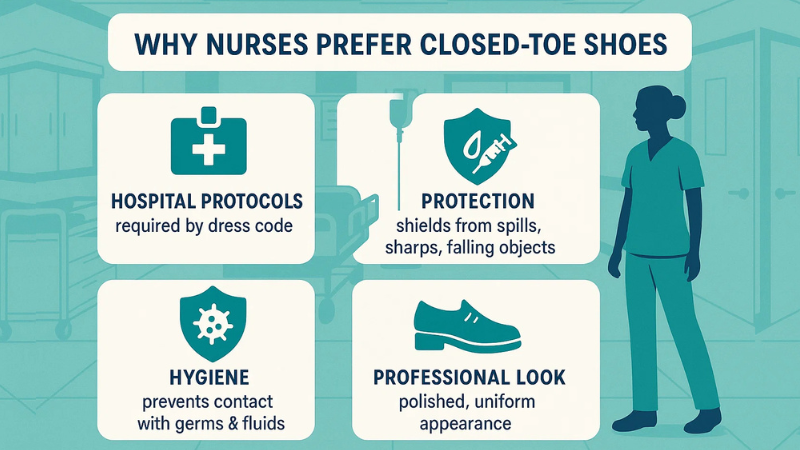
Why Nurses Prefer Closed-Toe Shoes
If you’ve ever walked through a hospital, you may have noticed one thing: almost every nurse wears closed toe shoes. This isn’t just about tradition — it’s about safety, hygiene, and professionalism. Let’s break down the reasons why nurses prefer closed-toe shoes:
1. Hospital Protocols
Most healthcare facilities have strict dress codes that require closed-toe footwear. Why? Because open-toe shoes increase the risk of exposure to infections and workplace hazards. Closed designs act as the first barrier between your feet and the clinical environment.
2. Protection from Hazards
Nurses are constantly exposed to unexpected situations. Closed-toe shoes provide critical protection against:
- Spills: blood, IV fluids, and chemicals.
- Falling objects: heavy equipment, medication trays, or even dropped instruments.
- Sharp items: needles or surgical tools that could cause injury.
3. Hygiene and Cleanliness
Hospitals are places where germs and fluids are part of the daily routine. Closed-toe shoes make it easier to maintain better hygiene standards since they prevent direct contact between your feet and potential contaminants.
4. Professional Appearance
First impressions matter in healthcare. Closed-toe shoes not only look more polished and uniform but also reinforce the image of a professional, reliable caregiver. Patients often feel more confident when their nurse looks well-prepared and properly equipped.
In short, nurses prefer closed toe shoes because they combine safety, hygiene, and professionalism. It’s one of those small but essential details that keeps both patients and nurses protected during long shifts.
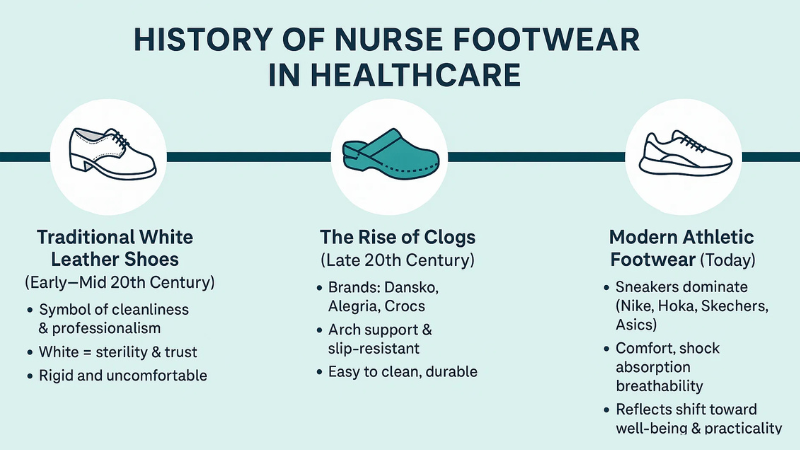
History of Nurse Footwear in Healthcare
The shoes nurses wear have changed just as much as the profession itself. Nurses have been in search of the perfect nursing shoes since ages. If you look back through the decades, the history of nurse footwear in healthcare tells a story of evolving expectations, workplace demands, and cultural shifts.
Traditional White Leather Shoes
Why do nurses wear white shoes? And that too a white leather one? The answer is simple yet complicated.
A perfect leather shoe is always appreciated in nursing. And if it is in white, it’s on another level of class. It’s a symbol of purity and peace. For much of the 20th century, nurses were almost always seen in stiff, all-white leather shoes. These shoes were more than just part of the uniform — they symbolized cleanliness, discipline, and professionalism in a field that valued order and precision.
- The bright white was a visual sign of sterility and trust.
- However, these shoes were often rigid and uncomfortable, offering little relief during long shifts.
- Many veteran nurses recall sore feet as a normal part of the job during this era.
The Rise of Clogs
By the late 20th century, practicality started to outweigh tradition. Enter the clog era. Brands like Dansko, Alegria, and later Crocs revolutionized nurse footwear.
- Clogs became famous for their arch support, slip-resistance, and durability.
- Their easy-to-clean surfaces made them ideal for messy hospital settings.
- They offered a sense of relief compared to leather shoes, quickly making them a staple in surgical and hospital units.
Modern Athletic Footwear
Fast forward to today, and you’ll often see nurses wearing athletic sneakers instead of traditional nursing shoes.
- Comfort, shock absorption, breathability, and slip-resistance are now top priorities.
- Popular sneaker brands like Nike, Hoka, Skechers, and Asics dominate hospital floors.
- This trend reflects a broader cultural shift toward comfort-driven, athletic-inspired designs — where healthcare professionals prioritize both function and well-being.
The history of nurse footwear in healthcare is more than just about shoes. It shows how the nursing profession has evolved from rigid uniformity to a more practical, comfort-focused approach that acknowledges the physical demands nurses face every single day.
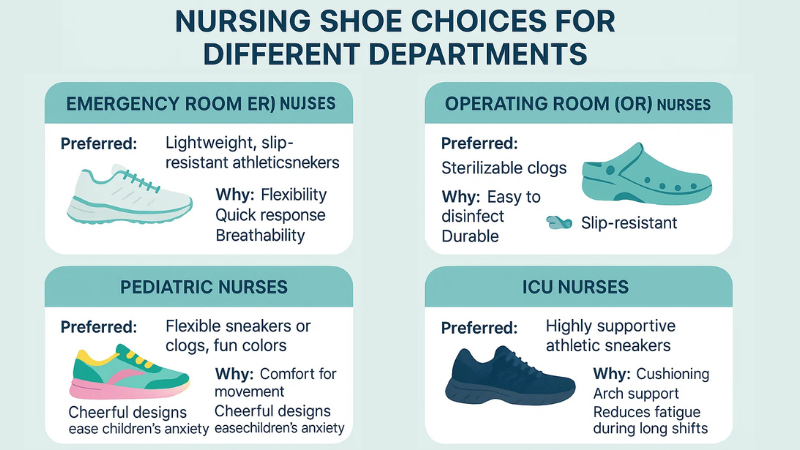
Nursing Shoe Choices for Different Departments
Nursing isn’t a one-size-fits-all profession, and the same goes for footwear. The demands of each department influence what kind of shoes nurses rely on to get through their shifts. Here’s a closer look at how nursing shoe choices for different departments vary based on the work environment:
Emergency Room (ER) Nurses
Life in the ER is fast-paced and unpredictable. Nurses are constantly on the move, responding to emergencies at a moment’s notice.
- Preferred shoes: Lightweight, slip-resistant athletic sneakers.
- Why: They provide the flexibility and quick response support needed when every second counts. Breathability is also key in such high-energy settings.
Operating Room (OR) Nurses
OR nurses work in highly controlled, sterile environments where safety and hygiene are top priorities.
- Preferred shoes: Sterilizable clogs made of materials that can withstand frequent cleaning.
- Why: Clogs are durable, easy to disinfect, and slip-resistant, making them perfect for surgical settings where spills and strict cleanliness standards are common.
Pediatric Nurses
Pediatric nursing requires both professionalism and a touch of playfulness to help children feel comfortable.
- Preferred shoes: Flexible sneakers or clogs, often in fun colors or designs.
- Why: Bright, cheerful footwear can put young patients at ease, while comfort and support allow nurses to kneel, bend, and move with ease during care.
ICU Nurses
Intensive Care Unit nurses often spend long hours monitoring critically ill patients, balancing quick interventions with extended periods of standing.
- Preferred shoes: Highly supportive athletic sneakers with cushioning and arch support.
- Why: These shoes reduce fatigue during long, sometimes stationary shifts while still providing stability when urgent action is needed.
As you can see, nursing shoe choices for different departments are not just about personal style — they’re about functionality, safety, and supporting the unique challenges of each specialty.
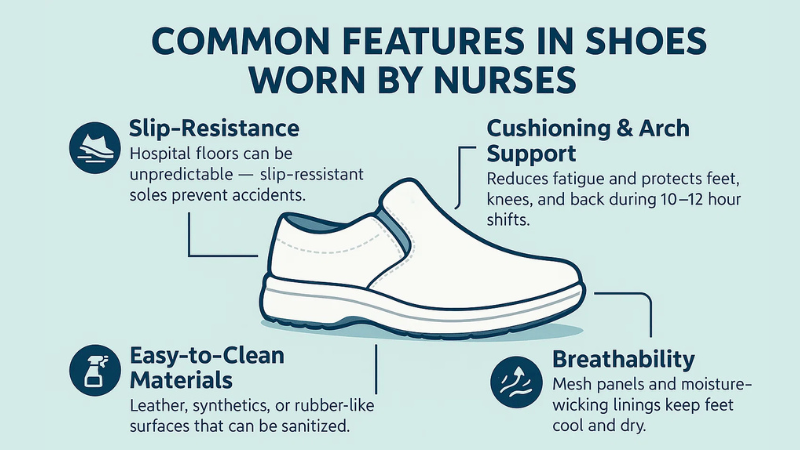
Common Features in Shoes Worn by Nurses
While every nurse has their own preference — sneakers, clogs, or slip-ons — most share a set of non-negotiable shoe qualities. These common features in shoes worn by nurses ensure safety, comfort, and performance during long shifts.
1. Slip-Resistance
Hospital floors can be unpredictable, with spills from IV fluids, medications, or even just water. Slip-resistant soles are essential to prevent accidents and keep nurses steady while moving quickly through hallways or patient rooms.
2. Cushioning & Arch Support
Standing or walking for 10–12 hours a day can take a toll on the feet, knees, and lower back. Nursing shoes are designed with ample cushioning and supportive arches to minimize fatigue and reduce the risk of long-term musculoskeletal issues.
3. Easy-to-Clean Materials
In a clinical environment, shoes are constantly exposed to fluids and disinfectants. That’s why many nursing shoes feature leather, synthetic uppers, or rubber-like materials that can be easily wiped down or sanitized without losing durability.
4. Breathability
Hot, tired feet can make a long shift even harder. Many nursing shoes include mesh panels, moisture-wicking linings, or ventilated designs to keep feet cool, dry, and comfortable — especially during back-to-back shifts.
These common features in shoes worn by nurses may seem simple, but together they provide the balance of safety, comfort, and practicality that nurses rely on every single day.
Conclusion
So, what shoes do nurses wear? The answer has certainly evolved over the years — from the crisp, white leather shoes that once symbolized professionalism, to today’s athletic-inspired sneakers and supportive clogs that reflect a focus on comfort and practicality.
No matter the style, the priorities remain constant: safety, comfort, durability, and support. The right pair of shoes doesn’t just complete a uniform — it protects nurses from slips, prevents fatigue, reduces the risk of injury, and helps them perform at their very best during long, demanding shifts.
FAQs: What Shoes Do Nurses Wear
What type of shoes are best for nurses?
Supportive, slip-resistant sneakers or clogs that balance comfort, safety, and durability.
Why do nurses wear clogs?
Clogs offer strong arch support, easy cleaning, and slip resistance — making them ideal for hospital use.
Are sneakers allowed in hospitals for nurses?
Yes, many nurses wear sneakers, provided they are closed-toe and meet safety requirements.
Do nurses still wear white shoes?
While traditional, all-white shoes are less common today, some hospitals and nursing schools still require them.
What features should I look for in nursing shoes?
Slip resistance, cushioning, arch support, breathability, and easy-clean materials.

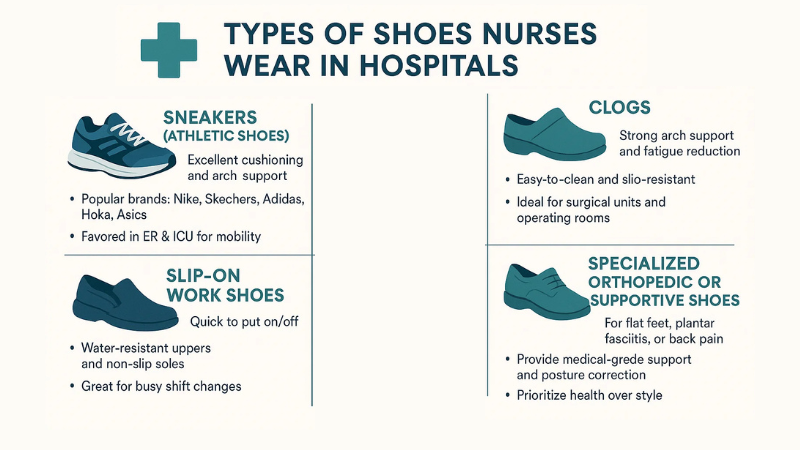
Leave a Reply